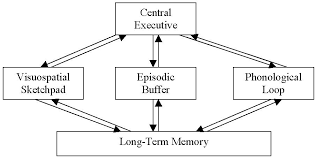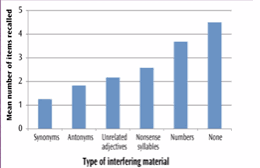memory
1/24
There's no tags or description
Looks like no tags are added yet.
Name | Mastery | Learn | Test | Matching | Spaced |
|---|
No study sessions yet.
25 Terms
the multi store model
created in 1968 by the Petersons, idea that we have 2 memory stores: long term and short term

short term memory (STM)
limited capacity to 5-9 units of information, duration is around 18 seconds, coding is mainly acoustic
long-term memory (LTM)
permanent memory store, only limited by death, coding is mainly semantic
coding
the format information is stored
acoustically= sounds
semantically= meaning
Peterson and Petersons research
the trigram theory - we can remember more information if its chunked into 3 words/letters/numbers as it makes then one singular unit
they found that the STM can hold information for around 18 seconds
Baddelys research in 1966
he presented participant with a list of 10 words and asked them to recall once from their STM and once from their LTM
he found that we make more acoustic errors in STM (fountain/mountain) and in LTM we make more semantic errors (hill/mountain)
Millers research in 1956
researched capacity of STM and the idea of chunking
he discovered we can hold 5-9 units of information in the STM at one time
Barricks research in 1975
he tested uni grads on putting names to yearbook photos
after 15 years of graduation there was 90% accuracy and after 48 years it dropped to 70%
3 types of long term memory
Episodic (events in your life)
Semantic (meaning of words/facts)
Procedural (skills/how we do things)
The working memory model
Proposed by Baddley in 1975

WMM central executive
An attentional process that assigns a slave system to each task, limited storage capacity
WMM phonological loop
Preserves auditory infomation, consists of phonological store and articulatory process
WMM Viso-spatial sketchpad
Stores visual and spatial information, consists of visual cache and an inner scribe
Episodic buffer
Tempera storage of both types of information and transfers it to LTM
Strengths of the WMM
Patient KF had brain damage - his phonological loop was damaged but other aspects of his memory was fine
Baddley found participants performed higher when doing two tasks at a time if one was visual and one was verbal rather than two of the same kind
Limitations of WMM
The central executive doesn’t have enough research done on it and it could be too simple
We can’t scientifically prove/disapprove the model
two explanations for forgetiing
interference
retrival failure
Pro active interference
Old information interfering with new information
retro active interference
New information interferes with old information
What makes interference worse?
Similarity in the information, research by McGough and McDonald gave participants two lists of words to memorise and then asked them to recall the 1st list, if the two lists were synonyms inference was much higher compared to numbers

retrival failure
the idea that all of our memories are stored in our brains but we are often unable to retrive them due to a lack of cues
external cues
context-dependant e.g. place or weather
internal cues
state-dependant e.g emotion or being drunk
encoding specifity principle
a cue must be both present when the memory is first coded and when it is retrieved (Tulving)
retrieval failure theory evaluation and real world application
Baddeley concluded that cues are important but don’t fully explain how or why we forget, it should be used alongside interference theory for the best understanding
students would get better scores in tests if they were sat in the classroom that the lessons were taught in